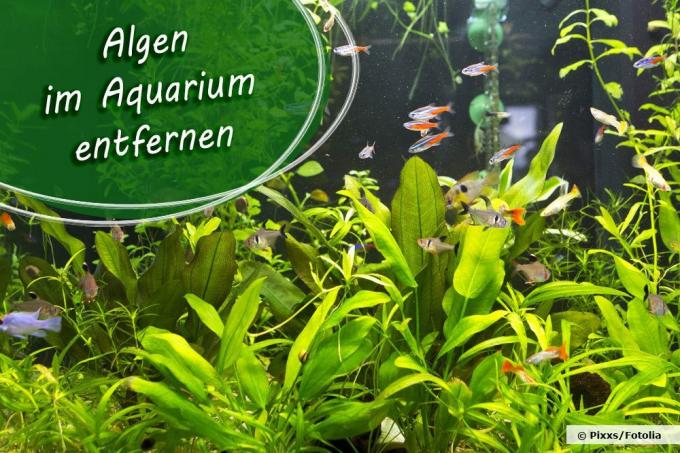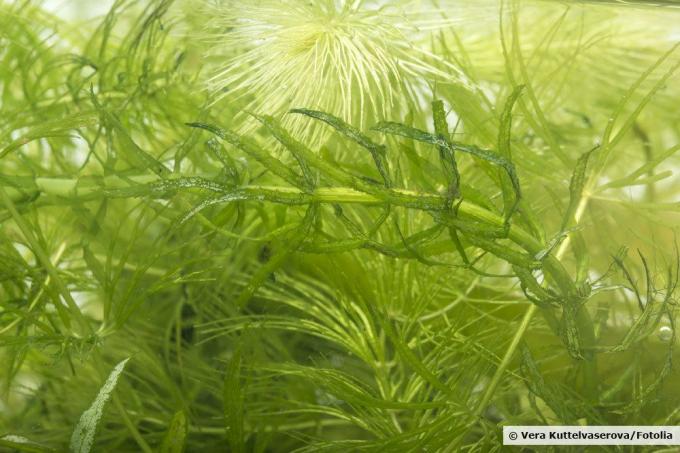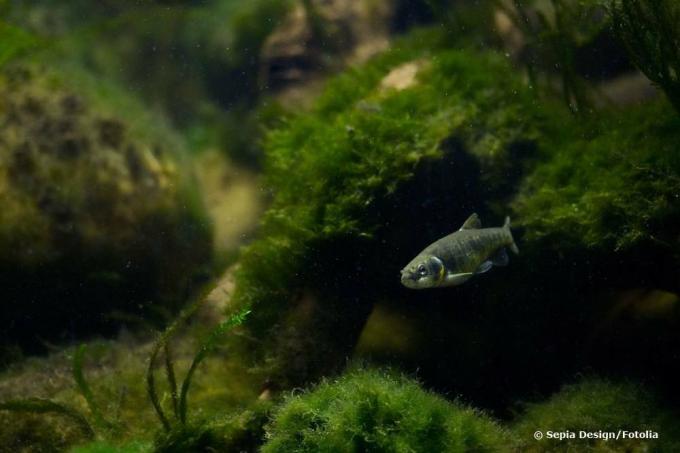
table of contents
- causes
- Different types of algae
- Blue-green algae
- Green algae
- Red algae
- Diatoms
- Remove algae: home remedies
- Design of the aquarium
- Create the right lighting conditions
- Create balance
- Plant aquarium
- straw
- Prevent
Algae have already spoiled the pleasure of many aquarists in their passion. Once the microorganisms have formed, they multiply like a dime a dozen. Quick action is required now. After all, the unpleasant aquatic plants indicate an unbalanced ecosystem. The aquarium not only suffers from this visually, some types of algae even have a negative effect on the health of the fish. Now it is time to remove the algae. Fortunately, a variety of biologically sound alternatives also exist. The best thing is that most of the home remedies are already available in every ordinary household.
causes
Algae in the aquarium can only be removed effectively and in the long term if the cause of their formation is known. Only with the knowledge of the exact trigger is it possible to find the right home remedy. The most common causes include:
- dead plant remains
- stale water
- Feces or undiscovered fish carcasses
- too high a phosphate content in the water
Note: An aquarium is a small biotope. Every living being contributes to a functioning symbiosis. An excess of algae indicates an imbalance in this tiny habitat.
Different types of algae
In order to successfully combat the aquatic plants, in addition to the analysis of the cause, the To identify exact algae species, here is a brief overview of the most common species and theirs Characteristics:
Blue-green algae
- actually not algae, but bacteria
- recognizable by the bluish-green film over the furnishing elements of the aquarium
- damage the filter system
- very persistent
- indicate an excessively high nitrate content
- Control measure: dark location, exchange half of the water for three days, predators (snails, suckers)
Green algae
- highly developed algae species
- shows up as green spots on discs and young plants
- arise when there is an excess of nutrients
- Control measures: predators (honeycomb sign catfish, blue antenna catfish, Siamese algae)
Thread algae
- Subspecies of the green algae
- arise when there is too much light and nutrients
- rapid spread
- infect aquarium plants at the roots, causing them to die off
- Control measures: Amano shrimp
Red algae
- thrive with strong water movement (good nutrient supply)
- occur with low CO₂ content
- Control measure: Increase CO₂ content
Brush algae
- Red algae subspecies
- grow in the corners and edges of the aquarium
- prefer strong currents
- the most unpopular type of algae due to its massive expansion
- dark green to black color
- occur with too many nutrients and too little CO₂
- Control measures: remove infested plants, predators (black-mouthed calf, barbel, guppy), vacuum gravel, reduce current
Bearded algae
- Red algae subspecies
- recognizable by small hairs
- very persistent
- cover furnishing elements and filter systems
- arise either from a lack or excess of nutrients
Diatoms
- Brownish coating on stones, plants and other furnishing elements, oxygen bubbles
- arise when there is a lack of light and too high a carbonate content
- Control measures: deprivation of nutrients through feeding competition (fast-growing plants, piping mouths), sucking off gravel, replacing a third of the water with softer water

Note: To remove the various types of algae, the trade offers a variety of chemical agents. If the use of fungicides also promises a very high success rate, the use of toxic substances is nevertheless not advisable. As I said, an aquarium is an ecosystem that fungicides would destroy. In addition, these funds only help in the short term. Long-term disposal using natural materials is then certainly the better choice.
Remove algae: home remedies
In order to remove algae, there is no great expense required. Even small interventions, changes and home remedies can help to eliminate them in the long term and even prevent the formation of algae. Some methods are somewhat controversial, but others have proven to be very effective. Of course, the suitability of a home remedy always depends on the fish population, the space available and the type of algae present.
Design of the aquarium
With the right setup of an aquarium, it is possible to take action against certain aquatic plants. Each water basin should be equipped with a filter. Its performance, however, depends on the size of the aquarium and the number of people living in it fishes. Two filter systems are ideal, one of which sucks up coarse dirt such as excrement and another filter removes fine dirt particles from the water.
The flooring also plays an important role. For example, blue-green algae prefer light-colored pebbles. The exchange with dark stones drives away the unpleasant plants in no time.
Create the right lighting conditions
Decisive for the formation of algae are not only the conditions inside the aquarium, but also external influences. In particular, the supply of light is decisive for plant growth. Plants need brightness in order to carry out photosynthesis. In doing so, they release nutrients into the water. Too much light creates a Nutrient excess, however, if it is too dark, the content is not sufficient. Different types of algae benefit from this imbalance.
Create balance
The relationship between aquarium size, fish population and furnishing elements should always be precisely measured. Lots of fish produce a lot of feces. A correspondingly powerful filter should be pointed out here again. The amount of feed must also be adapted to the number of inhabitants in the aquarium. If food remains are left over, they serve as food for the algae. In addition, certain fish species act as natural predators. So that they can also feed on the algae, it is advisable to give them a reduced amount of food so that the fish do not eat their fill.
Plant aquarium
Plants are direct competition for algae growth. Both living things need nutrients to thrive. Rapidly growing aquarium plants thus deprive the unwanted rivals of the necessary nutrients. They also regulate the CO₂ content of the water through photosynthesis. Diverse planting is advisable. Because a monoculture would have the opposite effect.
Another important aspect is fertilization. Choosing the wrong fertilizer quickly leads to an oversupply of nutrients. Deficient nutrients should, however, be supplied in a targeted manner. A precise water analysis is therefore highly recommended.
straw
A popular, simple home remedy for removing blue-green algae and the like is straw. Although it is primarily used in garden ponds, it is also effective in removing unpleasant plants in a water basin.
- Dried barley or wheat straw are suitable
- There are four to five handfuls of straw for every liter of water
- Put the straw in a sealed plastic bag in the water basin
- poke small air holes in the plastic beforehand with a toothpick
- after about two days the algae population should recede
- Change the straw and plastic bag every ten days

Note: Money is still mistakenly considered an effective method to combat algae infestation in the aquarium. However, we strongly advise against this, as the copper is poisonous for the fish.
Prevent
The best way to prevent algae from forming in the first place is to prevent them. Any aspects that promote algae growth should be ruled out beforehand. The choice of location is the top priority of prevention. An aquarium must not be too sunny or too dark either. The light supply should not be less than ten hours and not more than twelve hours. Those who cannot guarantee the minimum of brightness in a natural way can make do with artificial lighting. On top of that, it is important to always check the water quality. Test strips are available from specialist retailers for this purpose, among other things to determine the nutrient concentration.
